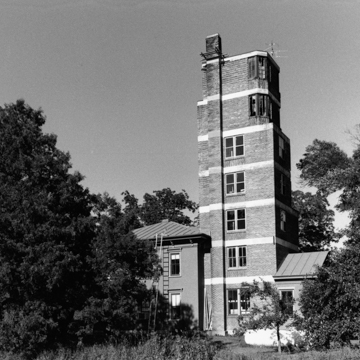This tower was built during the heyday of Wisconsin’s fox-ranching industry, which lasted from 1920 until 1945. In those years, Wisconsin supplied more than half of the fox pelts for the U.S. fur industry. Breeders built watchtowers like this one, following the recommendations of the American National Fox Breeders Association, so that they could observe the naturally shy animals without disturbing them. Most farmers demolished their towers after the fox industry declined in the mid-1940s. This substantial tower stands as a rare example of a once-common structure. The seven-story steel-frame structure rises in steps above the rear wing of a farmhouse built c. 1870. The streamlined industrial appearance of the tower, with its stepped-back massing and unadorned banded walls, seems incongruous with the farmhouse. Tan brick and tile cover the tower’s exterior walls, and concrete stringcourses delineate each floor. The second and third stories functioned as living quarters, with the next three floors providing storage. At the top, an observation room overlooked rows of fox pens that sloped away from the house.
You are here
Cole Watch Tower
If SAH Archipedia has been useful to you, please consider supporting it.
SAH Archipedia tells the story of the United States through its buildings, landscapes, and cities. This freely available resource empowers the public with authoritative knowledge that deepens their understanding and appreciation of the built environment. But the Society of Architectural Historians, which created SAH Archipedia with University of Virginia Press, needs your support to maintain the high-caliber research, writing, photography, cartography, editing, design, and programming that make SAH Archipedia a trusted online resource available to all who value the history of place, heritage tourism, and learning.















